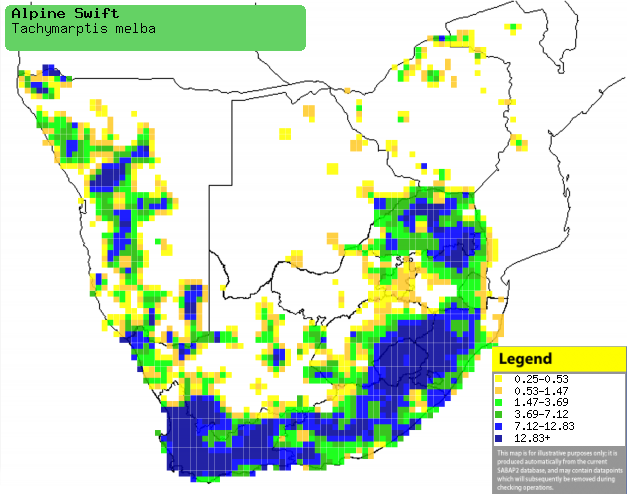|
Tachymarptis melba (Alpine swift)
[= Apus melba]
Witpenswindswael [Afrikaans]; Ihlabankomo, Ubhantom [Xhosa];
Sisampamema (generic term for swallows, martins, swifts and spinetails) [Kwangali];
Lehaqasi (generic term for swifts), Lehaqasi-le-lephatsoa [South Sotho];
Nkonjana (generic term for swift) [Tsonga]; Pêolwane, Phêtla (generic terms
for swifts, martins and swallows) [Tswana]; alpengierzwaluw [Dutch]; Martinet à
ventre blanc [French]; Alpensegler [German]; Andorinhão-real [Portuguese]
Life
> Eukaryotes >
Opisthokonta
> Metazoa (animals) >
Bilateria >
Deuterostomia > Chordata >
Craniata > Vertebrata (vertebrates) > Gnathostomata (jawed
vertebrates) > Teleostomi (teleost fish) > Osteichthyes (bony fish) > Class:
Sarcopterygii (lobe-finned
fish) > Stegocephalia (terrestrial
vertebrates) > Tetrapoda
(four-legged vertebrates) > Reptiliomorpha > Amniota >
Reptilia (reptiles) >
Romeriida > Diapsida > Archosauromorpha > Archosauria >
Dinosauria
(dinosaurs) > Saurischia > Theropoda (bipedal predatory dinosaurs) >
Coelurosauria > Maniraptora > Aves (birds) > Order: Apodiformes >
Family: Apodidae
The Alpine swift is patchily distributed across sub-Saharan
Africa, and is most common in southern Africa, especially in Namibia and South
Africa. It forages in mixed species flocks, along with other swifts and
swallows, and can travel up to about 1000 km's in a day! It tends to fly at
extremely high altitudes, however it does occasionally come down to the ground
to feed on grasshoppers, honey bees, etc. It is a colonial nester, living in
colonies of about 20-35 breeding pairs, who construct bowl-shaped nests, usually
placed so that they bridge a vertical rock crack, with multiple nests often
stacked on top of each other, like apartment blocks. Nests tend to be reused
over multiple breeding seasons, in fact a 28 year old colony has been recorded
in the Western Cape.
Distribution and habitat
Patchily distributed across sub-Saharan
Africa, from Ethiopia south to southern Africa. Within southern Africa it occurs
in Namibia, eastern Botswana, northern and southern Zimbabwe, western
Mozambique, Swaziland, Lesotho and South Africa. Breeds in mountainous areas,
but it can forage over
almost any habitat, generally preferring alpine grassland and fynbos.
|
 |
|
Distribution of Alpine swift in southern Africa,
based on statistical smoothing of the records from first SA Bird Atlas
Project (©
Animal Demography unit, University of
Cape Town; smoothing by Birgit Erni and Francesca Little). Colours range
from dark blue (most common) through to yellow (least common).
See here for the latest distribution
from the SABAP2. |
Predators and parasites
Movements and Migrations
Partial intra-African breeding
migrant, as it has a resident population in Namibia and a migratory population
in the rest of southern Africa. This population arrives here around August,
going through its full breeding cycle before leaving around May,
although some individuals stay here throughout the winter.
Food
It forages in mixed species flocks along
with other swifts and swallows, sometimes travelling up to about 1000 km's in a day!
It tends to fly at extremely high altitudes, however it does occasionally come
down to the ground to feed on insects. The following food
items have been recorded in its diet:
Breeding
- Monogamous, colonial nester, living in colonies of
about 20-35 breeding pairs, sometimes including other species such as the
African black swift.
- The nest is built by both sexes, consisting of a roughly bowl-shaped
platform, made mostly of feathers, grass and leaves glued together with
saliva. It is usually placed so that it bridges a vertical rock crack, with
multiple nests often stacked on top of each other like apartment blocks. It
can also be placed in horizontal crevices, buildings and even concrete
silos. Nests tend to be reused over multiple breeding seasons, in fact a 28
year old colony has been recorded in the Western Cape.
- Egg-laying season is from August-January.
- It lays 1-2 eggs, which are incubated by both sexes for about 17-23
days.
- The chicks are cared for by both parents, leaving the nest at about
45-55 days old.
Threats
Not threatened, in fact its range has greatly increased
recently due to the increasing availability of man-made nest sites.
References
-
Hockey PAR, Dean WRJ and Ryan PG 2005. Roberts
- Birds of southern Africa, VIIth ed. The Trustees of the John Voelcker
Bird Book Fund, Cape Town.
|
